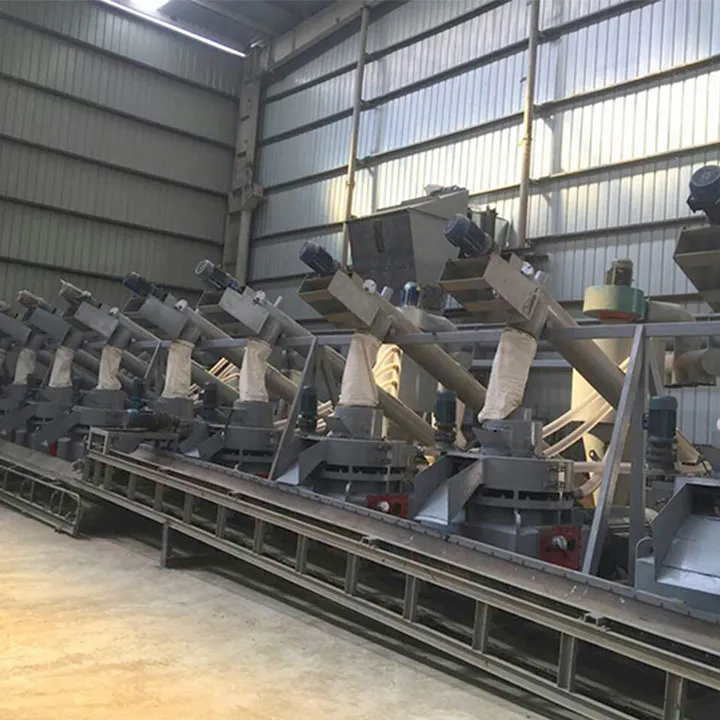Types of Biomass Pellet Machines
2024-07-25
A biomass pellet machine is a type of equipment used to compress and convert various forms of biomass into pellets. These pellets are commonly used as a renewable energy source for heating and power generation, as well as for animal feed and other applications. Here’s an overview of biomass pellet machines, including their features, benefits, types, and considerations:
Features
1. Pelletizing Mechanism:
- Die and Roller System: Most biomass pellet machines use a die and roller system where biomass material is forced through a die under pressure, forming pellets. The die has holes of specific diameters, creating pellets of uniform size.
- Pressing System: Can be flat die or ring die, each with specific applications and benefits.
2. Material Handling:
- Feed Hopper: A large hopper for feeding raw biomass materials into the machine.
- Conditioner: Some machines include a conditioner that adds moisture and heat to the biomass before pelletizing, improving pellet quality and efficiency.
3. Power Source:
- Electric Motor: Most modern pellet machines are powered by electric motors, offering consistent performance and efficiency.
- Diesel Engine: Some machines use diesel engines, making them suitable for areas without access to electricity.
4. Cooling and Drying:
- Pellet Cooler: After extrusion, pellets are often hot and require cooling. Pellet machines may include built-in coolers or require external cooling systems.
- Dryer: For materials with high moisture content, a dryer may be used to reduce moisture levels before pelletizing.
5. Control System:
- Digital Controls: Modern machines often feature digital control panels for adjusting settings such as pressure, temperature, and feed rate.
- Automation: Some models offer automation features for improved efficiency and ease of use.
Benefits
1. Renewable Energy Source:
- Sustainability: Biomass pellets are made from renewable materials such as wood chips, agricultural residues, and organic waste, providing a sustainable alternative to fossil fuels.
- Carbon Neutral: The combustion of biomass pellets is considered carbon neutral, as the carbon dioxide released during burning is offset by the carbon absorbed during the growth of the biomass.
2. Efficiency:
- High Energy Density: Pellets have a higher energy density compared to raw biomass materials, making them more efficient for heating and power generation.
- Low Ash Content: Properly processed pellets produce less ash and are easier to handle and clean.
3. Versatility:
- Various Applications: Biomass pellets can be used for heating, power generation, animal feed, and even in certain industrial processes.
- Adaptability: Pellet machines can process a variety of feedstocks, including wood, straw, rice husks, and other agricultural residues.
4. Ease of Handling:
- Uniform Size: Pellets are uniform in size and shape, making them easier to handle, store, and transport compared to loose biomass materials.
- Automatic Feeding: Automated feeding systems can improve efficiency and reduce manual labor.
Types of Biomass Pellet Machines
1. Flat Die Pellet Machine:
- Design: Features a flat die with rollers that press the biomass through holes to form pellets.
- Applications: Suitable for small-scale production and processing of materials such as wood sawdust and agricultural residues.
2. Ring Die Pellet Machine:
- Design: Features a ring-shaped die with rollers that compress the biomass from the outside inwards.
- Applications: Ideal for large-scale production with higher output capacities and the ability to process a wide range of materials.
3. Small-Scale vs. Large-Scale Machines:
- Small-Scale: Compact and suitable for small farms, home use, or pilot projects.
- Large-Scale: High-capacity machines designed for industrial production with advanced features and automation.
Considerations
1. Material Characteristics:
- Moisture Content: Biomass material should have an appropriate moisture content for pelletizing, typically between 10-15%. Excessive moisture can lead to poor pellet quality and machine issues.
- Material Type: Different materials may require specific processing conditions or machine settings. Ensure compatibility with the types of biomass you plan to use.
2. Machine Capacity:
- Production Volume: Choose a machine with the appropriate capacity for your needs, whether for small-scale or large-scale production.
- Efficiency: Consider the efficiency of the machine in terms of energy consumption, pellet quality, and output.
3. Maintenance and Support:
- Regular Maintenance: Pellet machines require regular maintenance to ensure optimal performance and longevity. Follow the manufacturer’s maintenance schedule and guidelines.
- Technical Support: Ensure that technical support and spare parts are available from the manufacturer or supplier.
4. Cost and Investment:
- Initial Cost: Consider the initial investment cost of the pellet machine, including installation and setup.
- Operational Costs: Factor in ongoing costs such as energy consumption, maintenance, and raw material procurement.
Applications
1. Heating:
- Residential and Commercial Heating: Used in pellet stoves and boilers for residential and commercial heating applications.
- Industrial Heating: Used in industrial processes that require high-temperature heat.
2. Power Generation:
- Biomass Power Plants: Pellets can be used in biomass power plants for electricity generation.
3. Animal Feed:
- Livestock Feed: Pellets made from agricultural residues or other biomass can be used as animal feed.
4. Agricultural Use:
- Soil Conditioning: Some pellets can be used as soil conditioners or mulch in agricultural applications.
Conclusion
A biomass pellet machine is a versatile and efficient tool for converting various types of biomass into pellets, offering benefits in terms of energy efficiency, sustainability, and ease of handling. Whether for small-scale or industrial production, selecting the right machine based on material type, capacity, and application needs is crucial for achieving optimal performance and productivity. Regular maintenance and proper operation will ensure the longevity and effectiveness of the pellet machine.



